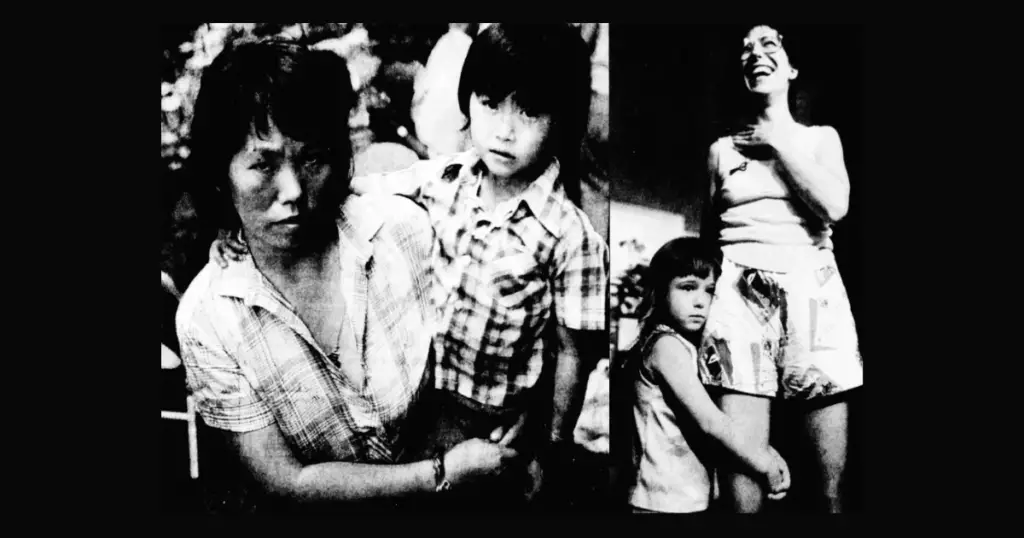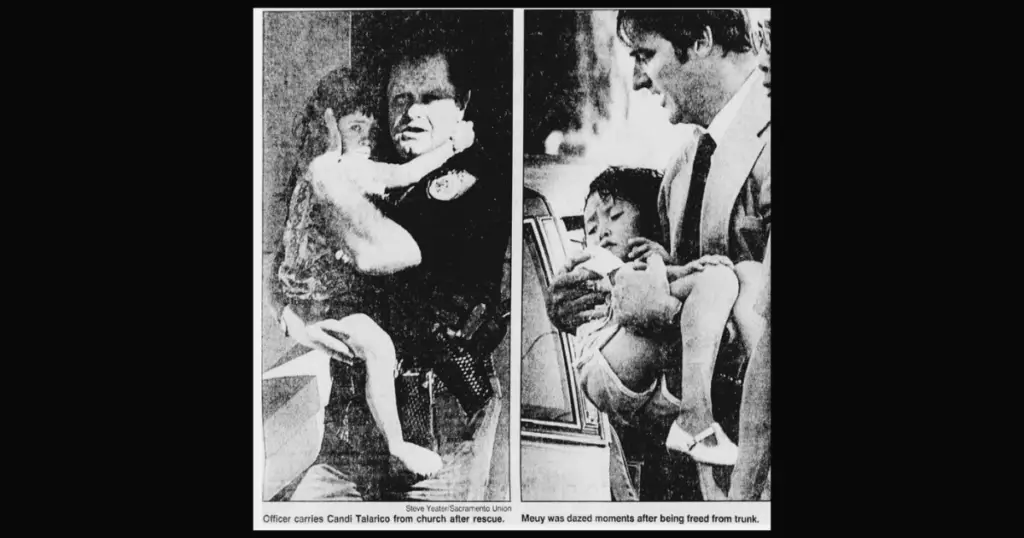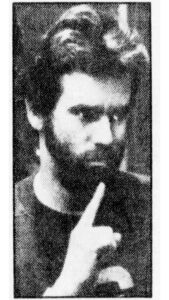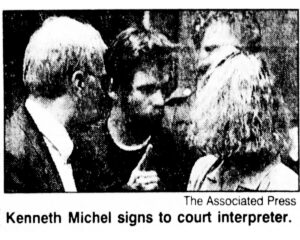Candi Elizabeth Talarico, 4, lived with her mother, Diane Van Gilder, 29, in an apartment at 2500 Q Street in Sacramento, California. On June 4, 1988, Candi played outside with two friends, ages three and seven, in an alley between Q and R Streets.
Dawn Martin, the youngest girl’s mother, checked on the children and told them not to climb in the dumpster or talk to strangers. Dawn then joined Diane in her apartment.
Minutes later, Dawn’s daughter flew into Diane’s apartment in a distressed state.
“Mom, Candi is in a car with a man!”
Candi’s seven-year-old friend, Gina Gocher, ran home to her mother. “A man just kidnapped my friend!” she cried.
Gina said the man had approached them as they sat with their backs to the alley. The three-year-old friend asked Candi, “Is that your daddy?” right before the man grabbed Candi and threw her into his car.
Candi fought, kicking and screaming. “Mama, help me!” The man sped away with Candy inside.
By the time Diane and Dawn ran outside to the alley, there was no trace of the car in sight. Diane immediately called the Sacramento police.
Search for Candi
Public and private agencies launched a search for Candi, including the now-defunct Kevin Collins Foundation — started by the father of Kevin Collins, 10, who disappeared from San Francisco in February 1984.
Candi’s kidnapper was described as a white male, 25–35 years of age, between 5-feet-9 and 5-feet-11, and weighing 165 pounds. He had dark brown, collar-length hair and a dark brown mustache. He wore a short-sleeve blue shirt and jeans and drove a late-model, baby-blue car.
The witness said the man also had a tattoo on one arm.
Investigators immediately ruled out Candi’s father, James Talarico, 28, because he was incarcerated at the Correctional Training Facility at Soledad for the past three years.
On June 8, 1988, four days after the abduction, an 18-year-old bicyclist told police she saw Candi near her home, wrapped in a blanket and crying in the back of a light blue Ford car. Police launched a frantic downtown search with dogs, helicopters, and patrolmen searching door-to-door. However, nothing turned up.
‘America’s Most Wanted’ recreated Candi’s kidnapping on June 19, 1988, reaching an estimated 100,000 homes across Sacramento County and thrusting the case into national status.
Though investigators received tips and sightings and stopped numerous blue cars to question drivers, nothing panned out.
Botched Kidnapping Leads to Miraculous Rescue
At 8 am on Monday, July 18, 1988, 44 days after Candi Talarico’s abduction, six-year-old Daisy Jones walked with her sister Hannah to summer school at James McKee Elementary in Elk Grove, a small community roughly 15 miles southeast of Sacramento in Sacramento County. As the girls trekked along Elk Grove Boulevard, a man in a blue Ford Escort grabbed Daisy and threw her into his car.
Daisy managed to slide over to the passenger door and exit the vehicle. Hannah screamed, and the kidnapper sped off, but not before Hannah got a partial license plate number.
The screams alerted a woman who had witnessed Daisy struggle with her kidnapper. The woman followed the man and wrote the license plate number: 1 SMK 423.
Another witness, Leonard Jack Manzer, 43, was driving to work on Elk Grove Boulevard when he saw the man carrying Daisy. The man made a U-turn in front of Manzer, and Manzer took note of the license plate number. He did not connect it to the Talarico case and debated calling the police. However, at 11:15 am, he reported the attempted abduction and gave authorities the license plate number.
Between both witness accounts, investigators knew this man was Candi’s kidnapper; the suspect and car description matched Candi’s case. Finally, there was a breakthrough in the kidnapping.
Kidnapper Strikes Again
The Saefong family lived in an apartment complex near 35th and Y Streets in Sacramento, only a few miles from Candi’s abduction site. Weun Meng and Nai Liem Saefong, who were Mien tribespeople from Laos and did not speak English, came to America with their children from a Thailand refugee camp to provide them with a better life.
At 1:45 p.m. on July 18, 1988, the same day as Daisy’s attempted kidnapping, Meuy Han Saefong, 5, filled a balloon with water from a spigot outside the apartment complex. She had just returned from summer school and was playing with friends. A man in a blue car pulled up to the curb, exited, grabbed Meuy, and forced her into his car.
Yao Ting Saetern, who lived upstairs from the Saefongs, had just stepped onto his balcony for fresh air when he witnessed Meuy’s abduction.
“I heard the child yelling, ‘Momma, momma, help me!'” Saetern said. The kidnapper sped off with the little girl trapped inside.
Saetern saw the kidnapper’s face and license plate number; however, he could not read English but made out three numbers: 4, 2, and 3.
When police were notified of Meuy’s kidnapping, they compared the partial plate number to the license plates in the earlier attempted kidnapping and knew it was the exact vehicle. Investigators ran the whole license plate number and got a hit.
The blue car belonged to Kenneth Alvin Michel, 32, from Elk Grove.
At 3:30 p.m., 18 unmarked police cars headed to Elk Grove. Police swarmed Michel’s apartment, just around the corner from Elk Grove United Methodist Church, and kicked in the door, but Michel was not there.
The police staked out his apartment, and at 5:49 p.m., Michel drove up to the church. Two Sacramento police officers and two FBI agents arrested him.
Michel motioned for a piece of paper. Michel was deaf and mute and needed to relay a message on paper. He wrote: “Girl is in the car.”
The officers opened the scorching trunk and found Meuy Han Saefong in a cardboard box, with her arms and legs bound and duct tape covering her mouth.
Michel then pointed to the church basement.
Underneath the stairwell was a storage area that had been boarded up. The officers pulled off some plywood, and one crawled through a hole to get in. He found Candi alive inside.
It was a cool spot with a dirt floor. Michel had provided Candi with a blanket, coloring books, and a television. She had been well-cared for, and police thought Michel might have fed her with food from the church pantry.
One officer grabbed Candi and handed her to Sgt. David J. Wilson of the Sacramento Police Department, who took her out of the church. He later called the rescue the most emotional experience in his then-23 years as a police officer.
Wilson: “I really felt it was Candi Talarico, by the hair. And tears came into my eyes the second she was handed to me. She grabbed hold of me pretty tight. I don’t think she wanted to let go for a while.”
Police said Candi had likely been in the basement since the day of her abduction. While she was imprisoned, no one in the church ever heard cries for help or saw anything that raised suspicion.
The police theorized that Candi might have been obedient and made no noise. She also could have been suffering from Stockholm Syndrome, a condition in which victims come to sympathize with their captors.
Dr. Inlow: “There is a crawlspace beneath the church about four feet high. He went in there, and then he sawed a hole in that crawl space floor, and it created another space that was then three or four more feet below the floor of the church.
“Even if somebody had gone down there to check for termites or whatever, he had covered up the hole. It was covered by the wood he sawed. Who knows if you could have heard her even if she was screaming down there?”
Both girls were immediately taken to University Medical Center (UMC) for examination and listed in good condition. The Saefongs and Diane Van Wilder reunited with their daughters at the hospital.


A City Celebrates
When Candi’s mother received word that her daughter had been found alive, she jumped up and down with excitement and relief. She shouted outside to neighbors who heard the commotion, “She’s coming home! The FBI is coming. My baby’s coming home. They’re coming to get me. It’s her!”
Shortly after, an FBI agent arrived at Diane’s home, and the two left for the hospital, both silent to the excited crowd outside.
Gina Gocher, Candi’s friend who witnessed her abduction, prayed every night for her friend’s safe return and prayed for her nightmares to stop.
“I kept thinking, what if he came for me,” Gina told a reporter as she waited for Candi’s release at UMC.
Tony Ammirato was also at the hospital. Police had selected him to portray the kidnapper on ‘America’s Most Wanted.’ An officer overseeing re-creations spotted him while working at Macy’s department store.
“I was told not to shave, grease my hair back into a ponytail and wear a fake mustache. It was scary because I realized how easy it was for the real guy to change his look, and I was worried that they wouldn’t be able to catch him.”
A dozen kids rode their bikes up and down the sidewalk, caught in the festive atmosphere of the young girl’s rescue. Cars honked. People waved.
Neighbors hung a “Welcome home, Candi” sign with balloons on her apartment door.
One neighbor from upstairs, Elizabeth Mayhugh, told The Sacramento Bee that a man she had never seen before passed by walking his two dogs. “He gave me $10 and said give this to Candi when she gets home.”
Candi and Meuy were released from UMC on July 19, 1988.
When Diane and Candi returned home, friends, neighbors, reporters, and strangers waited outside and showered Candi with gifts. They praised Diane for never losing hope.
Diane told reporters, “This is a miracle, and, like I’ve said all along, miracles happen if you have faith. I guess this is proof.”
Candi seemed a little paler than usual and had lost some weight, Diane said. Candi also picked up a bit of sign language from Kenneth Michel.
Diane worked tirelessly in the search for her daughter. She had planned to hand-deliver 250,000 posters of Candi and her abductor that week to local United States Postal Service substations for mass distribution.
Only four other children in the past four years were found alive at the time of Candi’s abduction and recovery.
Kenneth Alvin Michel
Those who knew Kenneth Alvin Michel were shocked when they discovered he kidnapped the little girls.
Reverend Dr. Linda Inlow, an Elk Grove United Methodist Church pastor, said Michel had worked at the church as a handyman since October 1987.
She and others described Michel as a hard worker and a nice guy who kept to himself. He usually came in early to make coffee and often stayed late.
According to Dr. Inlow, Michel also helped in the church daycare but was placed on leave because of personal problems that raised concerns about having him around children. He never molested the children, but they often teased him over his disability. One time, he pinched a child out of frustration.
After that incident, the church sent him to a psychologist. He was supposed to attend an appointment the day the girls were found.
Michel’s father was deceased, and his mother was estranged from the family. His sisters lived in other cities, so Michel was utterly alone.
Glenn Goldberg, director of the Norcal Center on Deafness in Sacramento, told The Sacramento Bee in 1988, “Blindness separates people from things, but deafness separates people from other people. Without communication, something starts dying inside of people.”
In September 1988, while communicating with Superior Court Judge Carol through an interpreter for deaf people, Kenneth Michel pleaded guilty to ten felony counts with the understanding he would serve no more than 62 years and four months in prison (Wilson, 1988).
Two months later, on December 7, 1988, Judge Miller handed Michel his 62-year sentence — 41 years for Candi Talarico’s kidnapping and sexual molestation, 20 years for the abduction and sexual molestation of Muey Han Siefond, and one year and four months for the attempted kidnapping of Daisy Jones.
Miller told the court it was evident that Kenneth Michel was a severely disabled man, but she rejected the defense pleas for compassion and imposed the negotiated prison sentence. Miller said that Michel represented a “clear and continuing danger to young girls,” and the “protection of the community” demanded the recommended term (Wilson).
At the hearing, Dr. McCay Vernon, an expert on deafness psychology, studied the case and found Michel’s “one of the most traumatic life experiences of any deaf person I have known.”
Vernon told the court how Michel’s mother was exposed to rubella during the first two weeks of pregnancy, resulting in Michel’s deafness and aphasia, a disorder resulting from damage to parts of the brain responsible for language.
Even though Michel was of average intelligence, “his brain was like a very good computer with no program to permit him to receive information or to get information out to others around him,” Vernon testified.
He struggled to communicate with his family, and sign language was forbidden at his school. He learned to sign when he was in his 20s.
Vernon further said that Michel’s only exposure to sexual matters came through experience and observation. When Michel was a child, his grandfather sexually abused him. Because he was misdiagnosed as mentally retarded, Michel was placed in environments with institutional, multiple-handicapped persons who tended to be less inhibited about their sexuality, Vernon said.
Michel spent 27 years incarcerated at Corcoran State Prison until his death in October 2015.
Aftermath
Soon after Candi Talarico was found, the family moved from the apartment at 25th and Q Streets to another home in the Sacramento area.
Candi Talarico is now Candi Gaut. She is in her late thirties, married, and the mother of five children. She and her mother, now Diane Van Wilder-Armstrong, still reside in the Sacramento area.
Candi told CBS in 2015, “I try not to thank about that part of my life. It was so long ago, but I’ve moved on, and I think I’ve coped with it pretty well.”
No information is available on Meuy Han Saefong. Her family attended Michel’s sentencing in 1988 but left immediately without speaking to reporters.
Sources
Allim, Faizah. “Joy Erupted at Apartment When News Came.” Sacramento Bee. July 19, 1988.
“Janitor Receives 62-year term for kidnapping 3 girls.” Los Angeles Times. December 8, 1988.
Kell, Gretchen. “Kidnapping Shatters Asian Family’s Newfound Security.” Sacramento Bee. July 19, 1988.
Lopez, Tony. “The Kidnapping of Candi Talarico: 27 Years Later, Once-Missing Girl Now a Mom.” CBS Sacramento. May 20, 2015. Accessed June 19, 2023. https://sacramento.cbslocal.com/2015/05/20/the-kidnapping-of-candi-talarico-27-years-later-once-missing-girl-now-a-mom/
McClatchy News Service. “2 Girls Rescued; Kidnap Suspect Found at Church.” Modesto Bee. July 19, 1988.
McQueen, Mari. “4-Year-Old Sacramento Girl Abducted.” Sacramento Bee. June 5, 1988.
Walker, Bill. “Candi Rescued With 2nd Child: Elk Gove Man Seized at Church Where He Works.” Sacramento Bee. July 19, 1988.
Walker, Bill and Dale Maharidge. “Portrait of a Man Alone.” Sacramento Bee. July 20, 1988.






